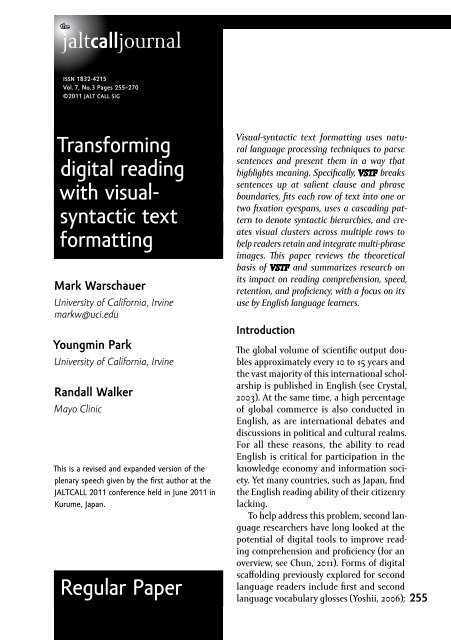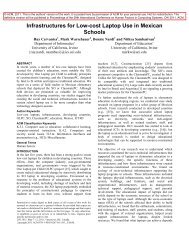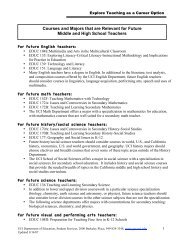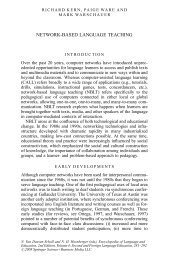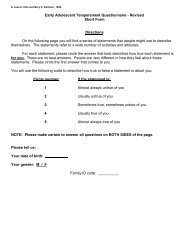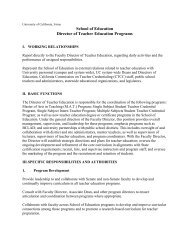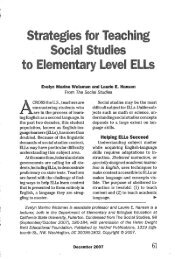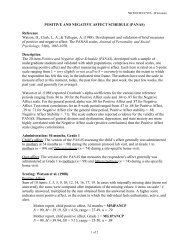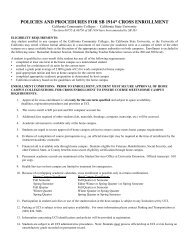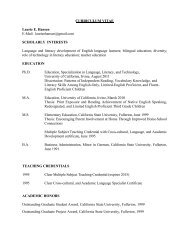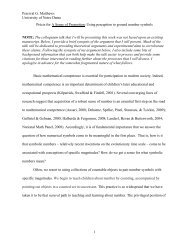Transforming digital reading with visual- syntactic text formatting ...
Transforming digital reading with visual- syntactic text formatting ...
Transforming digital reading with visual- syntactic text formatting ...
Create successful ePaper yourself
Turn your PDF publications into a flip-book with our unique Google optimized e-Paper software.
The jalt call Journal 2011: Regular Papers ( Conference Issue )<strong>visual</strong>, audio, and audio-<strong>visual</strong> supports (Chun & Plass, 2000); advance organizers (Len &Chun, 2007); highlighting of words (Hzang & Liou, 2007); <strong>text</strong>-to-speech (Roberts, Park, &Takahashi, 2010); and re-sequencing vocabulary introduction (Ryoo & Brown, 2008).All of these approaches assume that <strong>text</strong> is presented in the same traditional block <strong>formatting</strong>in which it typically appears in books. This <strong>formatting</strong> is arbitrary, though, andis not necessarily the most advantageous for <strong>reading</strong>, especially among second languagelearners.This paper discusses an alternate approach to <strong>digital</strong> scaffolding that involves a radicalre-thinking of <strong>text</strong> <strong>formatting</strong>. We first present a brief history of <strong>text</strong> <strong>formatting</strong> and<strong>reading</strong>, then analyze what the challenges are to <strong>reading</strong> in traditional block <strong>formatting</strong>,next introduce a new approach called <strong>visual</strong>-<strong>syntactic</strong> <strong>text</strong> <strong>formatting</strong> (VSTF), and finallysummarize research conducted on <strong>reading</strong> via VSTF.Brief history of <strong>formatting</strong> alphabetic <strong>text</strong>sThe structure and <strong>formatting</strong> of <strong>text</strong>s has changed a number of times over the millennia.The Phoenician alphabet was written in 2000 BC <strong>with</strong>out vowels, punctuation, lower caseletters, or spaces between words (Penney, 2006), which, in contemporary English, wouldyield sentences such as this:FRSCRNDSVNYRSGRFTHRSBRGHTFRTHNTHSCNTINENTNWNTIONCNCVEDNLBRTYNDDDCTDTTHPRPSTNTHTLLMNRCRTDQL256Vowels were added by the Greeks in about 1000 BC, and punctuation first appeared inAristophanes’s plays about 200 BC (Fischer, 2001). It took nearly another millennium, until700 AD, for lower case letters to emerge, which would render the above passage to appearlike this:Fourscoreandsevenyearsagoourfathersbroughtforth,uponthiscontinent,anewnation,conceivedinLiberty,anddedicatedtothepropositionthatallmenarecreatedequal.The above sentence is much easier to read, but still would be a challenge for anyone notalready familiar <strong>with</strong> it.A critical event in the development of literacy came <strong>with</strong> the insertion of spaces betweenwords, which first emerged in Irish manuscripts in the seventh and eighth centuries andspread throughout Europe starting in about 900 AD, a change that would thus render theabove sentence as follows:Four score and seven years ago our fathers brought forth, upon this continent, a newnation, conceived in Liberty, and dedicated to the proposition that all men are createdequal.This relatively simple change had a profound effect on literacy practices. Prior to the useof spaces between words, almost all <strong>reading</strong> was done orally – either aloud, in groups, orindividually, in a muffled voice – a necessary step to determine word boundaries and meanings.Word spacing facilitated the development of silent <strong>reading</strong> and thus, eventually, manyof the practices we consider essential to modern literacy, such as the retrieval of referenceinformation from a broad range of <strong>text</strong>s (Saenger, 2000).
Warschauer, Park & Walker: Digital <strong>reading</strong> <strong>with</strong> <strong>visual</strong>-<strong>syntactic</strong> <strong>text</strong> <strong>formatting</strong>Problems <strong>with</strong> block <strong>formatting</strong>Sentence <strong>formatting</strong> has changed little since the tenth century, but the widespread shiftof <strong>text</strong>s from paper to screen allows new possibilities previously impractical. Traditionalblock <strong>formatting</strong> of <strong>text</strong>s has two problems that can be addressed. First, due to limits of thehuman eye span, only nine to fifteen characters at average can be taken in at a time beforemoving to the next fixation when one reads conventional <strong>text</strong> (Demb, Boynton, & Heeger,1997). Everything else on the page competes for <strong>visual</strong> attention as readers get lost in a seaof words (Walker, et al., 2007; see Figure 1). That is why even skilled readers have difficulty<strong>reading</strong> <strong>text</strong>s <strong>with</strong> wide blocks of <strong>text</strong>s and tiny margins, as opposed, for example, to <strong>text</strong>sthat have been broken up into multiple columns.Figure 1. Limits of the human eye spanIn <strong>reading</strong> a block of <strong>text</strong>, when a person’s glance naturally shifts right to the next fixation,called a saccade, it sometimes requires regression to re-examine previously viewed wordseither due to interference <strong>with</strong> working memory (Garrod, 1992) or due to skipped words atthe edge of a fixation (Rayner & Sereno, 1994). This may not only slow the speed of <strong>reading</strong>,but also impede <strong>reading</strong> comprehension, especially in the case of poor readers.Skilled readers typically resolve this problem by grasping <strong>syntactic</strong> units in sentences,which helps them anticipate what should come next and how words, phrases, and clausesfit together in sentences to convey meaning. In oral speech, there are all sorts of clues tosuggest sentence syntax, from pauses, to word stress, to changes in pitch, pacing, andflow. In written <strong>text</strong>s, however, most of these clues are missing, which can result in readermisunderstanding. Eye movement research suggests that skilled adult readers do not onlyactivate a series of phonological segments, but also a prosodic structure during silent <strong>reading</strong>(Ashby, 2006).All of these factors make <strong>reading</strong> much more difficult for second language learners,who, in some cases, lack explicit knowledge of the target language syntax, or, in othercases, may know the explicit rules but cannot rapidly and automatically use those rulesto mentally process language. It is thus not surprising that knowledge of syntax has been257
The jalt call Journal 2011: Regular Papers ( Conference Issue )proven as one of the most salient factors in determining second language <strong>reading</strong> ability(see Shiotsu, 2010).Reading comprehension is thus eased both through narrower columns and <strong>syntactic</strong>allyorganized <strong>text</strong>s that assist readers in parsing <strong>syntactic</strong> meaning. This is seen both in computerprograms, which are always written in a cascaded format that highlights <strong>syntactic</strong>structure and meaning, and in poetry, which often is.Visual-<strong>syntactic</strong> <strong>text</strong> <strong>formatting</strong>Over the last 15 years, a team of researchers has developed a new type of <strong>text</strong>ual organizationcalled <strong>visual</strong>-<strong>syntactic</strong> <strong>text</strong> <strong>formatting</strong> (VSTF). VSTF uses natural language processingtechniques to automatically parse sentences and present them in a way that highlightsmeaning. Specifically, VSTF breaks sentences up at salient clause and phrase boundaries,fits each row of <strong>text</strong> into one or two fixation eye spans, uses a cascading pattern to denote<strong>syntactic</strong> hierarchies, and creates <strong>visual</strong> clusters across multiple rows that help readersretain and integrate multi-phrase images in their mind. VSTF also renders active verbs incolored font to further highlight meaning. The end result is a streamlined column of <strong>text</strong>that allows more efficient eye movement and <strong>syntactic</strong> processing. VSTF would thus renderthe above sentence from the Gettysburg address as seen in Figure 2 (<strong>with</strong> the highlightedwords colorized instead of bolded):Four scoreand seven years agoour fathersbrought forthupon this continenta new nation,conceived in libertyand dedicatedto the propositionthat all menare created equal.258Figure 2. Visual-<strong>syntactic</strong> <strong>text</strong> <strong>formatting</strong>VSTF can be accessed by readers in three ways. First, a software product called ClipRead isavailable for free from Live Ink, the company that developed VSTF. With ClipRead open ona computer, students can copy and paste any <strong>digital</strong> <strong>text</strong> into the program for automaticand rapid conversion to VSTF, and then simply page through it. Secondly, instructors canprepare materials ahead of time for a class using the same ClipRead program. Third, afew publishers have begun to partner <strong>with</strong> Live Ink to have their <strong>digital</strong> <strong>text</strong>books preconvertedto VSTF, <strong>with</strong> readers of the <strong>digital</strong> <strong>text</strong>s having the option of shifting to <strong>reading</strong>the VSTF version simply by clicking on an icon, thus obviating the need for any selectingand copying of <strong>text</strong>.
Warschauer, Park & Walker: Digital <strong>reading</strong> <strong>with</strong> <strong>visual</strong>-<strong>syntactic</strong> <strong>text</strong> <strong>formatting</strong>Research on <strong>reading</strong> <strong>with</strong> VSTFVSTF has been investigated in both laboratory and classroom settings, <strong>with</strong> junior high,high school, and college students, <strong>with</strong> very promising results (Vogel, 2002; Walker, Schloss,Fletcher, Vogel, & Walker, 2005; Walker & Vogel, 2005; Walker et al., 2007). Collectively,this body of research has addressed the following questions: (1) How does <strong>reading</strong> in VSTFas compared to normal block format affect <strong>text</strong> comprehension?; (2) How does <strong>reading</strong> inVSTF as compared to normal block format affect <strong>reading</strong> speed and efficiency?; (3) Howdoes <strong>reading</strong> material in VSTF over the course of a year affect general <strong>reading</strong> proficiency(i.e., when measured by the ability to read material in normal block format)?; (4) How does<strong>reading</strong> in VSTF compared to block <strong>text</strong>s affect the user experience?; and (5) What are theparticular effects of <strong>reading</strong> <strong>with</strong> VSTF on English learners? We will briefly summarize themethods, con<strong>text</strong>s, and results of key studies and interventions that relate to each of thesefive questions.Reading comprehensionWe have measured the impact on <strong>reading</strong> comprehension through several studies amongcollege students, all of which have found a benefit for VSTF (see, e.g., Walker, Schloss,Fletcher, Vogel, & Walker, 2005). In an earlier study, 48 college students read six 500-word expository passages from a computer display: three in standard block format andthree in VSTF. The order of passages and their format were randomized across participants.Immediately after <strong>reading</strong> the six passages, participants took a written test <strong>with</strong> 48 questionsaddressing the general nature of the <strong>text</strong>s, mid-level details, and specific details. Aone-way ANOVA revealed that scores on the comprehension test were 40% higher for thepassages read in VSTF as compared to those read in block format (p = .0024; see figure 3).Using students’ college admissions ACT test as a moderating variable, there was no significantimpact of the ACT <strong>reading</strong> subsection scores on outcomes; in other words, bothexcellent readers and mediocre readers achieved the same benefit in comprehension from<strong>reading</strong> <strong>with</strong> VSTF.Figure 3. Comparison of comprehension test scores259
The jalt call Journal 2011: Regular Papers ( Conference Issue )A more recent study confirmed these results, <strong>with</strong> an interesting added finding. In this study,we used a similar design to the above study, but in addition to VSTF and block format, weadded a third condition, random truncation. In random truncation, lines were shortenedto approximately the same length as that of VSTF, but they were not indented, and theline breaks were chosen randomly between words rather than by <strong>syntactic</strong> units. A totalof 27 US college students participated in the study, and the <strong>reading</strong> passages consisted ofscience articles taken from an encyclopedia and of similar length. Comprehension questionsincluded both <strong>text</strong> base questions, in which answers could be located <strong>with</strong>in one ortwo adjacent sentences in the <strong>text</strong>, and situation model questions requiring integration ofinformation from throughout the <strong>text</strong>.Results indicated that there were no differences in comprehension between <strong>reading</strong> inblock format and random truncation, but that the participants comprehended significantlybetter when <strong>reading</strong> VSTF than in either of these formats. In other words, narrower columnsalone did not prove advantageous for comprehension, but were beneficial only whencombined <strong>with</strong> cascaded <strong>syntactic</strong> <strong>formatting</strong>. On average, participants scored 20% higheron the comprehension tests in VSTF than in block format, <strong>with</strong> an effect size (Cohen’s d)of 0.25 (p
Warschauer, Park & Walker: Digital <strong>reading</strong> <strong>with</strong> <strong>visual</strong>-<strong>syntactic</strong> <strong>text</strong> <strong>formatting</strong>3.15 eye movements per word in the block <strong>text</strong> format, but only 2.25 eye movements perword in the latter format (see Figure 6).Figure 5. Average total fixation time (msec) per wordFigure 6. Average regressive eye movements per wordFinally, the combination of comprehension data and <strong>reading</strong> speed data in the same studyallows us to calculate the difference in <strong>reading</strong> efficiency (defined as amount of comprehensionper unit of <strong>reading</strong> time) between the two main conditions. As the participants scored25% higher in comprehension, and read at a 20% faster rate, we calculate the increase in<strong>reading</strong> efficiency due to use of VSTF at 50%.Reading retentionReading comprehension, speed, and efficiency are all of great value, but it is also importantthat students are able to retain information they read and thus learn academic contentfrom <strong>reading</strong>. Retention has been investigated through two studies of high school studentsusing VSTF to read content academic courses (Walker & Vogel, 2005; Walker et al., 2007).Both showed that students retained information better in VSTF.261
The jalt call Journal 2011: Regular Papers ( Conference Issue )For example, in 2003–2004, a study was carried out in six Grade 10 World History Classes,<strong>with</strong> three teachers each teaching two of the classes. First, the 84 students in the classeswere randomly assigned to one of the six classes. Then, the three teachers were randomlyassigned to teach one experimental course and one control course. A pretest showed thatthe students in the experimental and control groups were equivalent in academic ability,and the two groups also had similar proportions of gender and native language subgroups.The history <strong>text</strong>book used in the course was prepared for <strong>digital</strong> display and converted toVSTF. In each of the six classes, students read the <strong>text</strong>book material on computer in twicea week 25-minute sessions at a computer lab. The experimental group read the material inVSTF, whereas the control group read the material in block format. Both VSTF and block<strong>text</strong> electronic <strong>text</strong>book platforms permitted font enlargement, choice of dark or lightbackground colors, and a point-&-click table of contents. Block <strong>formatting</strong> for the controlgroups’ electronic <strong>text</strong>books used the same number of characters per line as was found inthe standard, paper-based <strong>text</strong>book, <strong>with</strong> left margin-only justification.Other than the <strong>text</strong>book <strong>reading</strong> condition, all other instruction for the two groups wasequivalent. Students had the same assignments and took the same unit exams (ten) andfinal exam (one) throughout the academic year. All of the exams were generated automaticallyby test-generator software and a question bank that the publisher provided <strong>with</strong> the<strong>text</strong>book. The unit exam covered material taught over the previous few weeks whereas thefinal exam covered material taught over the academic year.Exam scores of students in the experimental (VSTF) and control (block format) groupswere analyzed <strong>with</strong> a test of repeated measures multivariate analysis of variance, <strong>with</strong>pretest <strong>reading</strong> comprehension as an independent variable. Results showed that studentsin the VSTF classes scored significantly higher on both the unit exams and the final exam.Figure 7 shows the differences between the VSTF group and the block format groupon the ten unit exams. Students <strong>reading</strong> the <strong>text</strong>book <strong>with</strong> VSTF scored higher on each ofthe ten tests. In addition, there appears to have been a training effect, as the average gapbetween the scores of the VSTF group and the block format group was much higher in threeof the last four weeks than in had been in any of the first six weeks. Overall, the effect sizeof the difference in exams in the second half of the year (.55) was larger than the effect sizeof the differences in the first half (.375).262Figure 7. Unit exams in 10th grade History
The jalt call Journal 2011: Regular Papers ( Conference Issue )In contrast, in the middle school study, a comparison was made between <strong>reading</strong> VSTFon computer and <strong>reading</strong> the same material in block format in ordinary printed <strong>text</strong>books.In this study, 6th, 7th, and 8th grade students in the VSTF groups read social studies or languagearts material on laptops in their classrooms for a total of about 50 minutes per week.Block format students were selected from elsewhere in the district based on matched casecontrol: for each student in the VSTF group, a counterpart student was selected who hadcomparable attributes in terms of grade, baseline <strong>reading</strong> scores, English language learnerstatus, and gender. The block format students read the same social studies and languagearts material, but out of their ordinary printed <strong>text</strong>books. As the block format studentswere spread out in classrooms across the school district, there was no attempt to controlthe amount of time they spent <strong>reading</strong> the <strong>text</strong>book material.A total of 528 students participated in the studies, 384 in the middle school grades (6, 7,and 8) and 184 in the high school grades (9 and 10). In all grade levels, <strong>reading</strong> proficiencywas measured by scores on the <strong>reading</strong> section of the Measure of Academic Progress Testby the Northwest Educational Association (NWEA), a standardized test given in much ofthe United States. On this test, all <strong>reading</strong> comprehension test passages are formatted inconventional block <strong>text</strong>, and participants in the study took the tests in the ordinary manneras provided by the test publisher. Changes in <strong>reading</strong> proficiency were indicated by therelationship between the NWEA pretest given at the beginning of the school year in falland the NWEA posttest given at the end of the school year in spring. Pretest-posttest comparisonswere performed <strong>with</strong> an analysis of covariance, using pretest <strong>reading</strong> scores as theindependent variable and posttest <strong>reading</strong> scores as the dependent variable.In all five grade levels from 6th to 10th, students in the VSTF groups made significantlygreater improvements in their <strong>reading</strong> proficiency over the course of the year than did theircounterparts in the block format condition (see Figure 9). Students in the block <strong>text</strong> formatstypically made small gains throughout the year, advancing less than one grade levelwhen compared to national averages. In contrast, 6th, 7th, and8th grade students <strong>reading</strong>in VSTF made approximately two years’ worth of gains in a single year. Gains for 9th and10th grade students in the VSTF groups were also impressive; however, it is not possibleto quantify them in terms of years of growth since the NWEA <strong>reading</strong> test is not given ornormed past the 10th grade.The positive impact on <strong>reading</strong> proficiency through use of VSTF may appear counterintuitiveas the testing measures used involved <strong>text</strong>s written in regular block format thatthe participants had never seen. However, there are theoretical bases for understandinghow this transference from <strong>reading</strong> in VSTF to better <strong>reading</strong> in block <strong>text</strong> format mightoccur. Knowledge of syntax is shown to be an important precursor to <strong>reading</strong> ability, as isknowledge of English prosody (Korlat, Greenberg, & Kreiner, 2002). Other interventions,such as <strong>reading</strong> aloud to children, that help learners understand the prosody of structureof <strong>text</strong>s have similarly been shown to improve <strong>reading</strong> ability (Dowhower, 1991). The positiveimpact of VSTF use on general <strong>reading</strong> proficiency may be due to this training effect, asreaders gain a better understanding of how written passages are structured and are thusbetter able to subconsciously parse sentences they read. Additionally, there may also be aconfidence-building effect; as students realize they can successfully read and understandmaterial, they may approach new <strong>text</strong>s, in any format, <strong>with</strong> less fear or disinterest.264
Warschauer, Park & Walker: Digital <strong>reading</strong> <strong>with</strong> <strong>visual</strong>-<strong>syntactic</strong> <strong>text</strong> <strong>formatting</strong>Figure 9. Growth in <strong>reading</strong> proficiency in one academic yearUser experienceSurveys have been carried out of both high school and college students as to their preferenceto <strong>reading</strong> in VSTF or ordinary block <strong>formatting</strong> on the screen. All surveys showstrong preference for <strong>reading</strong> <strong>with</strong> VSTF. For example, in a survey of college students afterone hour of use, 60% indicated they found it easier to read in VSTF compared to only 20%who found <strong>reading</strong> easier in block <strong>text</strong> format (Walker & Vogel, 2005). Some 41% of collegestudents who read block <strong>text</strong> on the screen for an hour reported eye strain, comparedto 11% of those who read VSTF on the screen for the same amount of time, representing a73% reduction in reported eyestrain (Walker et al., 2005).Among high school students who used VSTF over the course of an entire school year, thepreference for the cascaded format was even greater. Some 85% of students indicated thatthey preferred VSTF whereas only 9.5% said they preferred to read <strong>digital</strong> material in block<strong>text</strong> format. High school students in the studies described previously were also given thechoice of abandoning <strong>digital</strong> <strong>reading</strong> during the year and reverting to their <strong>text</strong>books. Nostudents in the VSTF groups chose to do so.A study that we are currently carrying out in 50 4th and 6th grade classrooms inCalifornia, many <strong>with</strong> large numbers of English language learners, has provided furtherdata on learners’ experience <strong>with</strong> VSTF. All these classrooms are part of one-to-one laptopprograms, where students have access to an individual laptop computer throughout theschool day. At the time of this writing, we have completed approximately 30 observationsin classrooms using VSTF, and the students and teachers we have interacted <strong>with</strong> havebeen almost universal in their enthusiasm in <strong>reading</strong> <strong>with</strong> VSTF. One student told us, “Itis easier, faster and more fun to read <strong>with</strong> it because words are easier to see and the sentencesare broken up.” Another student said, “It is not only easy and fast, but also has moreinformation.” Although she did not elaborate on what additional information VSTF carriesto readers, it seems that she could distinguish more details and make more sense of whatshe read due to the way VSTF <strong>text</strong>s are parsed. Teachers were especially gratified to see howuse of VSTF <strong>text</strong>s boosted slow readers’ confidence in <strong>reading</strong>. Teachers have also told us 265
The jalt call Journal 2011: Regular Papers ( Conference Issue )that their students began <strong>reading</strong> in phrases when using VSTF, rather than just soundingout each word as they typically did when <strong>reading</strong> block <strong>text</strong>s. Some of the teachers whohave students <strong>with</strong> special needs, such as autism or vision problems, suggested that thisparticular format has worked well for such students, saying a laptop <strong>with</strong> VSTF <strong>text</strong>s is likean “added bonus.” Here is a dramatic example of this: According to a teacher, one student,who has an eye focusing and tracking problem, one day went home and said, “Mom, I canread like a normal person!”Effects <strong>with</strong> English language learnersAll of the above has referred to the general effects of <strong>reading</strong> in VSTF. What then do weknow about the particular effects of VSTF <strong>reading</strong> among English language learners? In ayear-long study <strong>with</strong> 9th grade students, greater gains were seen <strong>with</strong> lower aptitude studentsthan among those who were already good readers (Walker et al., 2005). They foundthat many of these students were English language learners who were able to achieve thesame <strong>reading</strong> proficiency level at the end of the year as the control group of native Englishspeaking readers. Walker and Vogel (2005) reported that the use of VSTF had a significantpositive effect on English language learners’ <strong>reading</strong> development across all secondarygrades, though, compared to their native peers, it took more sessions until their quizscores got an increase over control students. By the end of the year, in most grades, EnglishLanguage learners in the VSTF cohort had closed one-half to nearly the full gap betweenthemselves and the native English students in the control groups.How does this particular effect relate to what we know about second language <strong>reading</strong>in English? Among native English speakers, the size of one’s vocabulary is viewed as moreimportant than syntax in affecting <strong>reading</strong> ability, because vocabulary knowledge in one’snative language varies greatly while knowledge of syntax is relatively invariant (Shiotsu,2010). However, among English language learners, knowledge of syntax has been found tohave at least as great an effect, and in many cases, a greater effect on <strong>reading</strong> ability thandoes vocabulary size (see Shiotsu, 2010). Functional brain image studies also show that thepatterns of brain activity when one reads a foreign language are fundamentally differentfrom those when <strong>reading</strong> one’s native language (Dehaene et al., 1997; Kim, Relkin, Lee, &Hirsch, 1997). Similarly, a behavioral study demonstrated that the more dissimilar the <strong>syntactic</strong>rules of a target language are from one’s native language, the more difficult <strong>reading</strong>in the target language becomes (Frenck-Mestre & Pynte, 1997). All this helps explain whyEnglish learners in particular benefit from <strong>reading</strong> <strong>syntactic</strong>ally-parsed <strong>text</strong>s and why theyattain a training effect from doing so.This has been witnessed in schools and colleges. For example, Fisher and Newbury (2009)report that English learners at their community college find use of VSTF especially helpful,as it simplifies the <strong>reading</strong> process and makes complex passages easier to understand.Recently, a high school in Colorado has implemented a program for standardized test preparationfor low-performing students, two-thirds of whom are English language learners. Toprepare for the Colorado student assessment program (CSAP), the students participate in20-minute sessions on a daily basis for four weeks, <strong>reading</strong> sample test passages in VSTF.All of the students, who begin the preparation program at an unsatisfactory or partiallyproficient level, are able to improve their <strong>reading</strong> proficiency (Vogel, 2011). Most recently,81% of the participants met the Colorado state standard for acceptable growth in one year266 after a four weeks of 20-minute per day sessions, and 62% met the school goal of <strong>reading</strong>
Warschauer, Park & Walker: Digital <strong>reading</strong> <strong>with</strong> <strong>visual</strong>-<strong>syntactic</strong> <strong>text</strong> <strong>formatting</strong>at a proficient level by the end of the school year. Referring to the name of the softwarecompany that developed VSTF and has become synonymous <strong>with</strong> it, Vogel explained whyhe thinks it has been so successful in improving the <strong>reading</strong> proficiency of English learnersand other struggling readers:With <strong>reading</strong>, students in the first three grades develop word sense. Where we losekids after the third grade is <strong>with</strong> sentence and paragraph sense. Comprehension is inthe syntax. Kids get lost on the “garden path” because they can’t organize phrases andclauses into meaningful ideas. They re-read and waste time, becoming more frustrated.After a while, they forage instead of read. We have responded to these problems byabridging <strong>text</strong>s, in effect dumbing down the content. The best students breeze throughthese <strong>text</strong>books. It is an easy task, an easy “A.” The problem arises, when those brains,conditioned to read simple syntax, are challenged. I see it every year….One question always arises, “Well, kids can’t read from Live Ink all the time! What aboutthat?” I would suggest that there is a transfer effect to practicing Live Ink <strong>reading</strong>. TheCSAP tests that those students passed to proficiency were not in Live Ink. The ACT test,all the assessments I have tracked students by were not in the format, and there havebeen good solid gains in comprehension <strong>with</strong> these students. Anecdotally, students willtell me that they can “pull out the phrases” and “see the verb” easier <strong>with</strong> other <strong>reading</strong>after working <strong>with</strong> the format.ConclusionThere have many efforts to develop more effective techniques, approaches, and interventionsto aid second language <strong>reading</strong>, including better uses of technology. Nevertheless, at leastin some countries, <strong>reading</strong> skills in English as a foreign language seem to have stagnated.To address this situation, it is probably helpful to look at <strong>reading</strong> and <strong>reading</strong> education infresh ways. We have long taken <strong>reading</strong> in block format for granted, yet its arbitrary structuredoes not convey as much useful information for comprehension as spoken languagedoes. In contrast, considerable evidence suggests that VSTF provides valuable support, notonly for strengthening comprehension of the <strong>text</strong> at hand, but also for improving general<strong>reading</strong> proficiency. More expansive research on this promising approach is called for.ReferencesAshby, J. (2006). Prosody in skilled silent <strong>reading</strong>: evidence from eye movements. Journalof Research in Reading, 29(3), 318–333. doi:10.1111/j.1467-9817.2006.00311.xChun, D. (20011). CALL technologies for L2 <strong>reading</strong> post web 2.0. In N. Arnold & L. Ducate.(Eds.), Present and future promises of CALL: From theory and research to new directions inlanguage teaching (pp. 131–170). San Marcos, TX: CALICO.Chun, D., & Plass, J. L. (2000). Networked multimedia environments for second languageacquisition. In M. Warschauer & R. Kern (Eds.), Network-based language teaching:Concepts and practice (pp. 151–170). New York: Cambridge University Press.Crystal, D. (2003). English as a global language (2nd ed.). Cambridge: CambridgeUniversity Press.267
The jalt call Journal 2011: Regular Papers ( Conference Issue )268Dehaene, S., Dupoux, E., & Mehler, J. (1997). Anatomical variability in the corticalrepresentation of first and second language. Neuroreport, 8, 3809–3815.Demb, J. B., Boynton, G. B., & Heeger, D. J. (1997). Brain activity in the <strong>visual</strong> cortexpredicts individual differences in <strong>reading</strong> performance. Proceedings of the NationalAcademy of Science, 94, 13363–13366.Dowhower, S. L. (1991). Speaking of Prosody: Fluency’s unattended bedfellow. Theory intoPractice, 30 (3), 165–175.Fischer, S. R. (2001). A history of writing. London: Reaktion Books.Fisher, C., & Newbury, I. (2009). How innovation and effective technology transformed ElCamino College’s instruction for developmental <strong>reading</strong> students. Paper presented at theAssociation of Literacy Educators and Researchers. Charlotte, North Carolina.Frenck-Mestre, C. & Pynte, J. (1997). Syntactic ambiguity resolution while <strong>reading</strong> insecond and native languages. Quarterly Journal of Experimental Psychology, 50A(1),119–148.Garrod, S. (1992). Reconciling the psychological <strong>with</strong> the linguistic in accounts of <strong>text</strong>comprehension. Paper presented at the NORDTEXT symposium. Espoo, Finland.Hzang, H.-T., & Liou, H.-C. (2007). Vocabulary learning in an automated graded <strong>reading</strong>program. Language Learning & Technology, 11(3), 64–82.Kim, K. H., Relkin, N. R., Lee, K.-M., & Hirsch, J. (1997). Distinct cortical areas associated<strong>with</strong> native and second languages. Nature, 388, 171–174.Korlat, A., Greenberg, S. N., & Kreiner, H. (2002). The extraction of structure during<strong>reading</strong>: Evidence from <strong>reading</strong> prosody. Memory & Cognition, 20(2), 270–280.Len, H., & Chun, T. (2007). Reading authentic EFL <strong>text</strong> using <strong>visual</strong> and advanceorganizers in a multimedia learning environment. Language Learning & Technology,11(3), 83–106.Leu, J., Donald J., Kinzer, C. K., Coiro, J., & Cammack, D. M. (2004). Toward a theory ofnew literacies emerging from the Internet and other information and communicationtechnologies. In R. B. Ruddell & N. Unrau (Eds.), Theoretical models and processes of<strong>reading</strong> (pp. 1570–1613). Newark, DE: International Reading Association.Luke, A., & Freebody, P. (1999). A map of possible practices: Further notes on the fourresources model. Practically Primary, 4(2), 5–8.Penney, J. H. W. (2006). Writing systems. In E. Bispham & B. A. Sparkes (Eds.), TheEdinburgh companion to ancient Greece and Rome (pp. 477–484). Cambridge: CambridgeUniversity Press.Rayner, K., & Sereno, S. (1994). Eye movements in <strong>reading</strong>: Psycholinguistic studies. In M.A. Gersbacker (Ed.). Handbook of psycholinguistics (pp. 57–81). San Diego, CA: AcademicPressRoberts, K., Park, H. J., & Takahashi, K. (2010). Effectiveness of <strong>text</strong>-to-speech softwarefeatures for improving vocabulary, <strong>reading</strong> comprehension, and <strong>reading</strong> rate ofculturally diverse high school students in Hawai’i. In D. Gibson & B. Dodge (Eds.),Proceedings of Society for Information Technology & Teacher Education InternationalConference 2010 (pp. 1606–1611).Ryoo, K., & Brown, B. A. (2008). Teaching science as language: A “content-first” approachto science teaching. Journal of Research in Science Teaching, 45(5), 529–553.Saenger, P. (2000). Space between words: The origins of silent <strong>reading</strong>. Palo Alto: StanfordUniversity Press.
Warschauer, Park & Walker: Digital <strong>reading</strong> <strong>with</strong> <strong>visual</strong>-<strong>syntactic</strong> <strong>text</strong> <strong>formatting</strong>Shiotsu, T. (2010). Components of L2 <strong>reading</strong>: Linguistic and processing factors in the <strong>reading</strong>test performances of Japanese EFL learners. Cambridge: Cambridge University Press.Vogel, C. A. (2002). A program evaluation of the Live Ink format. Unpublisheddissertation, University of Denver College of Education.Vogel, C. (2011, February). CSAP and ACT bootcamp: Using the Liveink <strong>reading</strong> format.Paper presented at the Colorado Council International Reading Council AnnualConference, Denver, CO.Walker, R. C., Gordon, A. S., Schloss, P., Fletcher, C. R., Vogel, C., & Walker, S. (2007).Visual-<strong>syntactic</strong> <strong>text</strong> <strong>formatting</strong>: Theoretical basis and empirical evidence for impacton human <strong>reading</strong>. Paper presented at the IEEE Professional CommunicationConference, 2007, Seattle. 1–14. Retrieved from http://ieeexplore.ieee.orgWalker, S., Schloss, P., Fletcher, C. R., Vogel, C. A., & Walker, R. C. (2005). Visual-<strong>syntactic</strong><strong>text</strong> <strong>formatting</strong>: A new method to enhance online <strong>reading</strong>. Reading Online, 8(6).Retrieved from http://www.<strong>reading</strong>online.org/Walker, R., & Vogel, C. (2005). Live Ink: Brain-based <strong>text</strong> <strong>formatting</strong> raises standardizedtest scores. Paper presented at the National Educational Computing Conference,Philadelphia.Yoshii, M. (2006). L1 and L2 glosses: Their effects on incidental vocabulary learning.Language Learning & Technology, 10(3), 85–101.Author biodataMark Warschauer is Professor of Education and Informatics at the University of California,Irvine, and editor of Language Learning & Technology journal. His most recent book isLearning in the Cloud: How (and Why) to Transform Schools <strong>with</strong> Digital Media.Youngmin Park is a PhD student in Education at the University of California, Irvine, specializingin Language, Literacy, and Technology. Previously a high school teacher and teachertrainer in Korea, her research focuses on the use of <strong>digital</strong> media in the teaching andlearning of <strong>reading</strong>.Randall Walker, MD is an assistant professor of medicine at Mayo Clinic. His researchapplies natural language processing to improve <strong>text</strong> readability for persons <strong>with</strong> low-visionand <strong>reading</strong> disabilities, and has received awards for innovation and distinguished achievementfrom the US Department of Education and the Association of Educational Publishers.269


